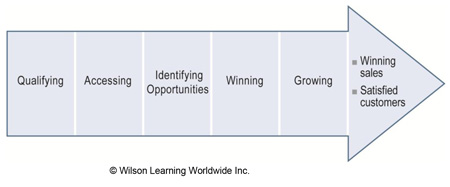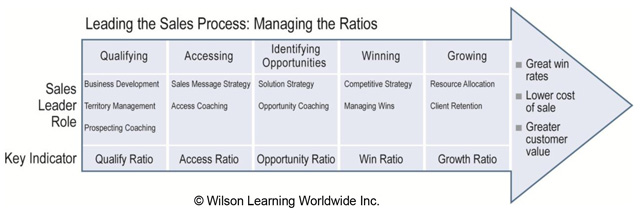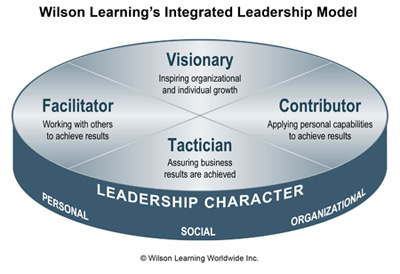Integrated Sales Leadership Development Approach
Managing the Process, Leading the People (Point of View Paper)

It is an all-too-common story: A top-flight salesperson is promoted to sales manager. The organization soon discovers, however, that the skills and perspectives that made this person a top salesperson are not contributing to success as a sales manager, and may in fact be contributing to the lack of success.
WHY DO GOOD SALESPEOPLE FAIL AS SALES MANAGERS?
Many of the perspectives and skills a salesperson acquires in developing an effective sales approach are inconsistent with the perspectives, skills, and environment of a sales manager. The accompanying table shows some of the major differences.
As a result of these differences, some sales managers fall back on old sales behaviors. They become "heroic managers" and start directly managing client relationships at the first sign of trouble. As a result, these sales managers do not add unique value to the organization and may even undermine their salespeople's feeling of confidence, credibility with customers, job satisfaction, and connection to the organization.
WHAT IS THE COST OF POOR SALES MANAGEMENT?
The cost of having an ineffective sales manager goes way beyond just the cost of hiring and training that manager. For example, in one large pharmaceutical company, senior managers calculated the costs of a single bad district manager as "in the millions!" The costs this company identified included:
- Loss from transitioning the customer base: Bringing in another salesperson to handle the manager's former accounts almost always results in some stalling or revenue reduction from these accounts.
- Salesperson attrition: If a high-performing salesperson sees that a manager will not help him or her in building business, that salesperson will move quickly to either another sales division or another company.
- Reduced salesperson effectiveness: When managers take a Heroic Manager approach, or provide limited guidance, many salespeople will become demotivated. Some will stop selling, while others will let the manager sell for them.
- Loss of good will in the marketplace: As salespeople leave and customers begin dealing with a string of "temporary salespeople," customers lose faith in the supplier.
- Difficulty in hiring: Replacing salespeople who leave becomes harder and more expensive as the reputation of that manager becomes more widely known.
| PERSPECTIVE DIFFERENCES | |
|---|---|
| SALESPEOPLE | SALES MANAGERS |
|
|
THE TWO SIDES OF SALES LEADERSHIP
While many salespeople fail to make an effective transition to sales management, many others succeed. What leads some to struggle and others to thrive? In our work with sales managers, we have found one primary reason: They must transition from a sales role with one primary purpose to a leadership role with two primary purposes:
- Managing the Sales Process
- Leading the Salespeople
Successful sales leaders embrace this dual role. First, they recognize that effective sales leadership involves supporting salespeople in executing the entire sales process. These sales leaders keep current on the status of sales opportunities and provide support and guidance through all steps of the sales process, without trying to heroically take control.
In addition, effective sales leaders recognize that the salesperson's environment is filled with tremendous ups and downs: win a big sale or account and the salesperson feels on top of the world; lose a customer or a big opportunity, and that salesperson feels that the world has ended. Effective sales leaders recognize that a major part of their job is to deal with this emotional turbulence, provide salespeople with focus and direction, and create an effective sales team.
MANAGING THE SALES PROCESS: MANAGING THE RATIOS
Our 40-plus years of experience with salespeople and sales managers has led us to a simple, but we believe true, statement about effective sales leadership:
One key job of a sales leader is to manage the sales process.
This is often a controversial issue and one that can make the transition from salesperson to sales manager difficult. After all, isn't it the job of the salesperson to manage the sales process?
From our perspective, the answer is NO! Salespeople execute on the sales process; sales leaders manage the sales process. In other words, the job of salespeople is to move a client or opportunity from initial qualification to a win. The job of the sales manager is to coach salespeople in each step of the process, analyzing inefficiencies in how the process is executed and working to improve the effectiveness of each process step.
Unfortunately, many organizations confuse these roles by compensating sales managers primarily on their salespeople's sales revenue. While this can drive some appropriate manager behaviors, we have found that this approach creates equally as many unproductive results. This type of compensation will lead many sales managers to actively execute, not lead, the sales process by becoming heroic managers or "super closers," taking over the relationship in the most critical accounts or otherwise undermining the motivation and credibility of their salespeople. This lowers the motivation of their high-potential salespeople, while making it more difficult to identify and remove ineffective salespeople.
We have found that by helping organizations and sales managers focus on how to lead the sales process, rather than the execution of the sales process, sales managers contribute unique value to the organization and grow a successful sales force. One of the most effective methods for getting sales managers to lead the sales process is to use management of the conversion ratios as their key success indicator. Focusing on these ratios will drive appropriate leadership behaviors among managers, and allows managers to focus on developing effective sales skills in their salespeople.
THE SALES LEADER'S ROLE IN MANAGING THE SALES PROCESS: MANAGING THE RATIOS

Most organizations follow some formal sales process, and all salespeople follow at least an informal process. While the process varies based on the complexity and type of sale, most include the general steps identified in the graph at right. The job of the salesperson is to execute on this process: qualifying customers, gaining access to key decision makers, identifying specific sales opportunities, winning the business, and growing the business inside that client organization.
While salespeople need to execute the sales process, sales leaders need to manage how effectively and efficiently the sales team and organization are moving customers through the sales process. We call this Conversion Ratio Management.
When sales revenue is down, most salespeople (and unfortunately most managers) have the same response-load up the front end of the pipeline. That is, if you are not winning enough sales, then you need more leads to get you more prospects to get you more appointments . . . and so forth. But loading up the front end is not always working smarter—it is just working harder. It is not the only, or best, way to increase sales. There is another approach that will burn out fewer salespeople and give sales managers the opportunity to add unique value.

Managers who work smarter rather than harder focus their energy on tracking the conversion ratios for the entire process, developing strategies to increase the ratios, supporting process improvement, and coaching salespeople to improve the ratios. This is the best way for a sales manager to add value to the organization. Consider this: A 10 percent increase in the number of leads can lead to a 10 percent increase in revenue. However, if a manager can help his or her salespeople make a 10 percent increase in all of the ratios, the result is a 46 percent increase in revenue!
Focusing on managing the ratios helps sales managers in a number of ways. First, it gives them a concrete set of performance measures. In turn, this provides an ongoing, frequent measure of performance (ratio improvement). It also gives a clear focus for the manager's coaching efforts. By using the ratios to identify bottlenecks in the sales process, support and coaching can be targeted on specific improvement goals that will have greater impact on overall sales performance.
LEADING THE SALESPEOPLE: THE FOUR LEADERSHIP ROLES
Half of a sales leader's job is Conversion Ratio Management. The other half is providing leadership to his or her sales team. While this sounds straightforward, it is important to recognize that salespeople are a unique group of employees: fiercely independent, often isolated geographically from the rest of the organization, devoted to their customers, and subject to great successes and even greater disappointments.
We have helped hundreds of organizations create leadership models, and one element that consistently emerges is the need to address both the "being" and the "doing" of leadership. The "being" of leadership is Leadership Character: the values and principles that guide the kind of leader a person is. Leadership Character is the foundation of effective leadership, but alone it is not sufficient. Unless this foundation is supplemented by the skills and knowledge needed to execute on those values and principles, the leader fails to produce tangible results. From our experience, the skills required to "do" effective sales leadership can be defined by four core roles that each leader must fulfill—Visionary, Tactician, Contributor, and Facilitator.

These roles complement each other, bringing their own value to effective sales leadership. It is the inability to appropriately balance these four roles that leads to some of the primary sales manager dilemmas. Sales managers will often say that their primary struggle is spending too much time dealing with information and administrative tasks and too little time coaching and building their sales team. In other words, the Tactician role dominates their day-to-day activities, so much so that they do not have sufficient time for the Visionary role (coaching their salespeople) or the Facilitator role (building their sales team). As a result, when their salespeople need help with an opportunity, the manager falls back on what he or she knows best—acting like a salesperson and being the heroic manager (The Contributor Role) to "fix the problem."
INTEGRATED SALES LEADERSHIP
Effective sales leadership is about both managing the sales process and leading the salespeople. They manage the sales process, not by duplicating what salespeople do, but by managing the ratios involved in converting a suspect to a growth customer. Effective sales leaders also provide leadership to their sales team through their Leadership Character and by balancing the four leadership roles: Visionary, Tactician, Facilitator, and Contributor.
Four Sales Leadership Roles
| Visionary | Tactician | Facilitator | Contributor |
|---|---|---|---|
| Guiding organizational and individual growth through creation and communication of a compelling vision and strategy. | Ensuring sales results are achieved through planning, delegating, reviewing performance, and improving systems and processes. | Creating an environment of collaboration and partnership to ensure effective working relationships. | Creating organizational success by contributing their personal talents, experiences, and abilities. |
| K E Y C O M P E T E N C I E S | |||
|
|
|
|
© Wilson Learning Worldwide Inc.
This approach to sales leadership helps in two ways. First, by focusing on leading the sales process via Conversion Ratio Management, sales leaders can more quickly separate the more important information and administrative tasks from the less important. This frees up time for the other leadership roles. By focusing on balancing the four leadership roles, managers more effectively coach, build their sales team, and create a common vision of success.
While all sales leaders need to provide leadership for the process and fulfill the roles of Visionary, Tactician, Facilitator, and Contributor, a given sales leader's specific role will vary depending on that leader's level and how the organization defines its sales strategy. Each organization will be somewhat different, so let's focus on two broad roles: first-line sales managers and sales executives.
First-line sales managers—those who directly manage individual salespeople—should focus their time and energy by leading the sales team through Conversion Ratio Management. Sales executives also need to put time and energy into the sales process, but their position is more focused on ensuring that the organization's systems, policies, and procedures are aligned with and support the sales process.
| Sales Process Role | Four Leadership Roles | |
|---|---|---|
Sales Managers:
|
Leading the Sales Process
|
Emphasis on:
|
Sales Executives:
|
Leading Sales Systems
|
Emphasis on:
|
© Wilson Learning Worldwide Inc.
In terms of the leadership roles, while first-line sales managers need to fulfill all four roles, they tend to emphasize skills in the Tactician and Facilitator roles, such as performance management and sales team development. In contrast, sales executives need to emphasize development of skills in the Visionary and Facilitator roles—ensuring a clear and meaningful vision for the organization and creating a culture of collaboration and teamwork.
Of course there are exceptions to this. In some organizations, first-line sales managers also carry accounts. Other companies have Key Account Managers or salespeople who lead an account team. These roles will require a blending of all or some of the roles described above. Analysis of the roles and responsibilities within the sales force will define just what part each member plays in leading the sales process and the leadership roles and skills they need to fulfill.
CREATING EFFECTIVE SALES LEADERS
While it is important to clearly define what makes an effective sales leader, how do you create effective sales leaders? Do you develop them, hire them, or both? How do you identify salespeople who can make the transition and thrive in the new role and how do you prepare them efficiently?
There are many ways to approach this topic, but let's deal specifically with transitioning a salesperson into sales management. We focus on this approach for a number of reasons. First, most sales managers are former salespeople and will make the transition at some stage in their career. Second, for many organizations, internal procedural and product knowledge makes the promotion of salespeople to sales managers the most efficient way to acquire additional first-line managers. Finally, the most common entry into first-line sales leadership is an internal promotion from the salesperson role.
Many of our clients have found that a simple three-step process is the most effective method for identifying, selecting, and developing new sales managers from their pool of existing salespeople. While any one organization may not implement every activity, following the basic process below has reduced the number of poor hiring decisions and increased the overall effectiveness of sales leadership.

Because the successful transition from salesperson to sales manager is greatly affected by the shift in perspective already described, we recommend beginning with activities to help salespeople "self-select" based on a realistic understanding of the sales manager job. Assessing the salesperson's interests and attitudes is a critical first step to see if he or she has a realistic perspective of the manager's required mind set. We also recommend either a self-directed learning or job shadowing activity so the salesperson can experience firsthand a day in the life of a sales manager. From this information, many salespeople will determine that they have no interest in being a sales manager; for others, the information will provide a realistic picture of what will be expected of them.
Following the self-selection is a more formal assessment of the salesperson's potential as a sales leader. In this step, salespeople go through simulations of critical situations that sales managers face and are assessed on their capability to deal with these situations. Other tools include a 180-degree assessment (self and manager) of leadership skills and performance-based interviews with sales managers and executives in the organization. At the completion of this step, both the salesperson and the organization will have a good understanding of whether this person has both the Leadership Character and skills to be successful as a sales leader.
Once the selection is made, the process of turning potential into reality begins. The sales leader development process should consist of both formal development activities and on-the-job learning activities. While there are many options for how to train and develop new managers, we have found the following to be critical components of this effort.
- Provide new managers with knowledge of the company's philosophy and perspective on leadership early in their development.
- Focus initial development on core leadership skills and management of the sales process through Conversion Ratio Management.
- Create a formal mentoring relationship between the new manager and a sales executive that will guide much of the on-the-job learning.
- Provide access to additional development resources that focus on specific skills.
- Conduct frequent assessment of skill needs.
CONCLUSION
All effective sales leaders have clarity of purpose regarding who they want to be as leaders and their ability to execute the roles of Visionary, Tactician, Facilitator, and Contributor. They also have a deep appreciation for their role in managing the sales process and supporting their salespeople's abilities to Qualify, Access, Win, and Grow business. Only through an integration of these elements can a sales leader effectively engage salespeople in fully committing their energy, creativity, and talents. Leaders who are role models for this integration express excitement about the possibilities of leadership. To them, leadership is being of service to others; despite the challenging times they face, there is an energy, excitement, and hope about the future that is inspiring to all those around them.
To learn more, contact Wilson Learning at 1.800.328.7937 or complete the online form.






 Please complete this form to download Integrated Sales Leadership Development Approach | Managing the Process, Leading the People (Point of View Paper).
Please complete this form to download Integrated Sales Leadership Development Approach | Managing the Process, Leading the People (Point of View Paper).



